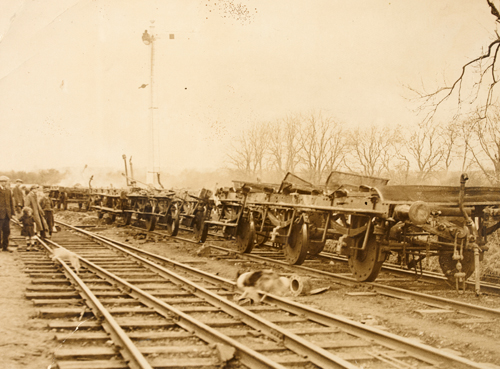More destruction on railways as Sligo train station set ablaze
Silgo, 23 Jan 1923 - The war on Irish railways is so dire, that the Dublin Correspondent of the Press Association has claimed, that only those absolutely compelled to travel should do so on trains.
The warning comes as reports of destruction of railway lines and property mounts and in the wake of news of the destruction of the Sligo railway terminus on 11th January, one of the country’s finest. The terminus was reduced to ruins and all the rolling stock set aflame after being doused in petrol. The attack on the premises by armed republicans occurred at night. It is believed the walls were mined and the stationmaster’s resident, ticket and parcel offices destroyed. The estimated cost of the damage is £80,000.
In response to reports about the incident, the local army headquarters in Sligo has defended the response of its troops and challenged some of the information put into the public domain. There was not, the local command suggests, a garrison of 500 men in situ on the night of the attack, but 70 men who were charged with guarding 100 prisoners as well as protecting three important posts in the town.
‘Small parties of troops from every post were out in the streets ten minutes after the first explosions were heard.’ Some of the small parties tried to rouse the Sligo Fire Brigade and others were sent out into the suburbs and country to pursue Irregulars whose sniping tried to keep them pinned behind the walls of the barracks.
‘Sligo is a town of over 11,000 population, and one of the most important commercial centres in the West. In the peaceful days of the Anglo-Irish war here there were some 300 British military and 70-80 police stationed in the town. Considering its limited numbers and resources, and the much better armed and equipped opposition it has had to contend with, the little garrison in Sligo has, comparatively speaking, not done too bad.’
Amongst the most recent attacks, a railway bridge was blown up between Kiltoom and Knockoroghery rendering it unuseable. Armed men blew up the bridge with a mine before holding up a mail train nearby shortly after. Passengers and company officials - the incident occurred on the Midland and Great Western Railway (MGWR) - were ordered off the train, after which the engine was restarted and the train directed to the breach, from where it tumbled down the embankment.
The discommoded passengers and staff were subsequently transferred to another train to complete their journey, but the incident - and the destruction of the bridge - caused serious disruption to the timetable. The plan is to continue services on the line by running trains to the damaged section and transferring passengers to another train on the other side. Even so, the traffic of live animals has been suspended until repairs are completed, with 70 wagons of cattle bound for the fair at Balla already held up.
Also on the MGWR line, the Kilfree Junction signal cabin, situated midway between Boyle and Ballymote, was burned to the ground by an armed party who had arrived at the location by motor car.
On the Great Southern and Western Railway (GSWR), there is no traffic in north Kerry beyond Listowel and damage to the line between Bagenalstown and Gowran has yet to be properly repaired. There has also been a break on the Birr branch.
Recent weeks have also seen major damage done to the railway system in West Clare while in Dublin, a portion of viaduct between Malahide and Donabate on the Great Northern Line was destroyed in an explosion that could be heard for miles around. A section of the Belfast-Dublin line was seriously damaged and trains were unable to pass.

Rail derailment between Dundalk and Iniskeen - ‘one of 42 derailments in six months (Image: Illustrated London News, 20 January 1923)
[Editor's note: This is an article from Century Ireland, a fortnightly online newspaper, written from the perspective of a journalist 100 years ago, based on news reports of the time.]





















